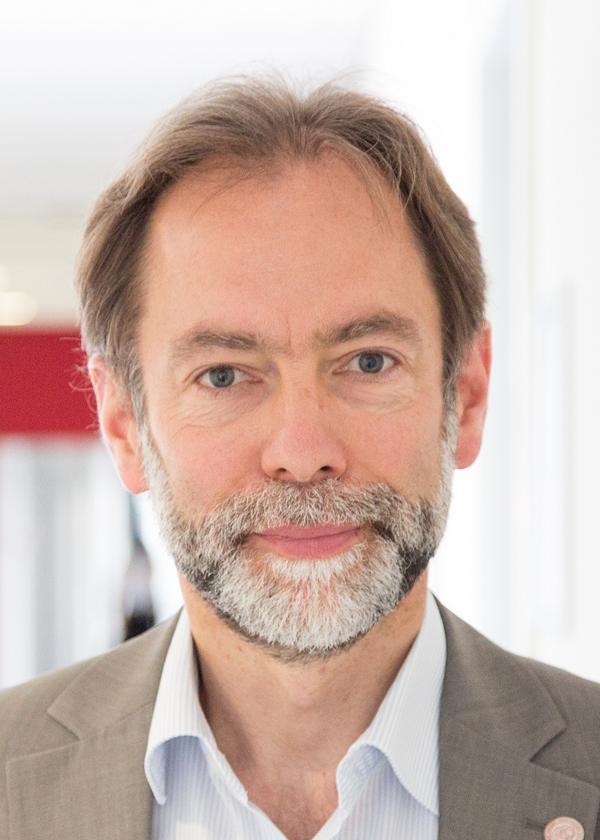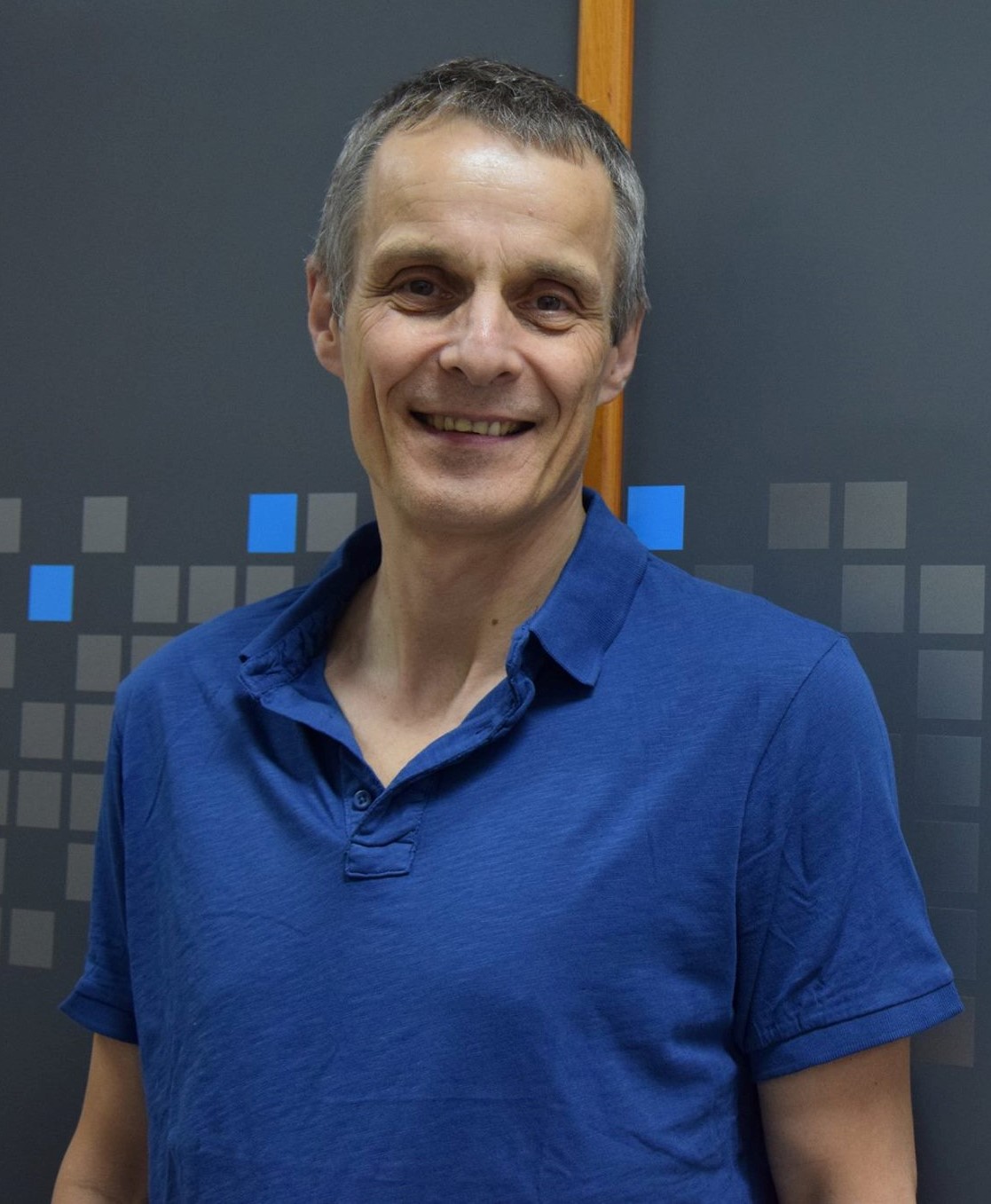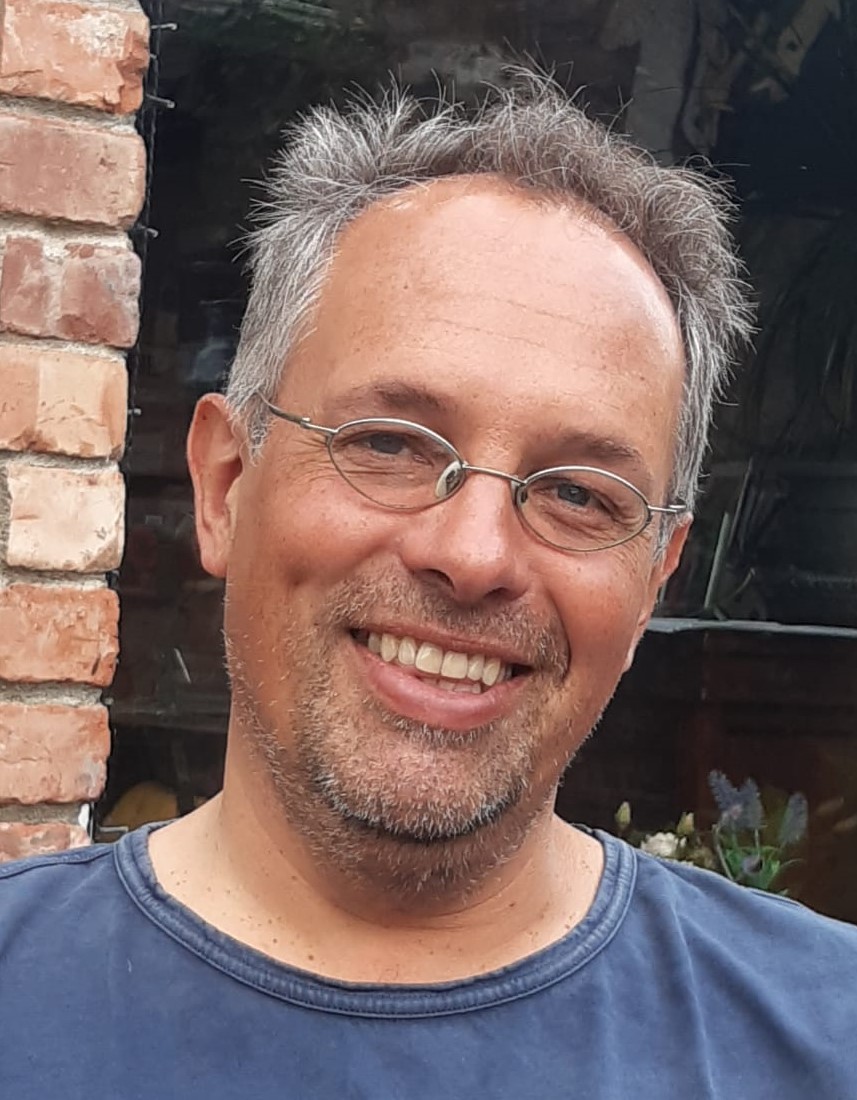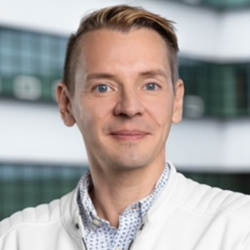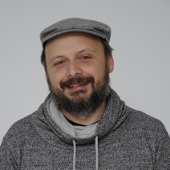2025
BIO-INSPIRED ELECTRONICS: THE POWER OF DE NOVO PEPTIDE DESIGN
Thu, 20-02-2025 10:00 am CEST (Europe/Warsaw)
Prof. Dr. Nurit Ashkenasy
Department of Materials Engineering and the Ilse Katz Institute for Nanoscale Science and Technology, Ben-Gurion University of the Negev, Beer-Sheva, Israel
Abstract
2024
COMBINING MATERIALS, CELLS AND METHODS IN 3D BIOPRINTING
Fri, 21-06-2024 10:00 am CEST (Europe/Warsaw)
Prof. Dr. Michael Gelinsky
Head of the Centre for Translational Bone, Joint and Soft Tissue Research
Abstract
CV
ENABLING MULTIFUNCTIONAL MATERIALS AND COMPOSITES THROUGH ADDITIVE MANUFACTURING AND NANOENGINEERING
Fri, 07-06-2024 10:00 am CEST (Europe/Warsaw)
Prof. Dr. Shanmugam Kumar
James Watt School of Engineering, University of Glasgow
Abstract and Bio
PHASE SEPARATION AND SMALL MOLECULE INTERFERENCE WITH AGGREGATION: TREATMENT OPTION FOR NEURODEGENERATION
Tue, 21-05-2024 10:00 am CEST (Europe/Warsaw)
Prof. Dr. Christian Griesinger
Max Planck Institute for Multidisciplinary Sciences, Goettingen
Abstract
CV
2023
EFFICIENT SINGLE-LAYER OLEDs WITH TRAP-FREE TRANSPORT
Fri, 17-11-2023 10:00 am CET (Europe/Warsaw)
Prof. Dr. Paul W.M. Blom
Max Planck Institute for Polymer Research,
Abstract
Efficient single-layer OLEDs with trap-free transport
Oskar Sachnik, Xiao Tan, Yungui Li, Gert-Jan A.H. Wetzelaer, Paul W.M. Blom
Max Planck Institute for Polymer Research, Ackermannweg 10, 55128 Mainz, Germany
The efficiency and stability of single-layer polymer light-emitting diodes is compromised by unbalanced charge transport, absence of triplet-exciton harvesting and low photoluminescence quantum efficiencies. We demonstrate that using thermally delayed activated fluorescence emitters in combination with trap-free transport high external quantum efficiencies are obtained. Our results show that OLEDs with a simplified single-layer structure can rival the efficiencies of complex multilayer stacks.
CV
CONTEXTUALIZATION OF METABOLIC NETWORK MODELS AND THEIR APPLICATION TO DRUG REPURPOSING
Thu, 26-10-2023 10:00 am CEST (Europe/Warsaw)
prof. Thomas Sauter
University of Luxemburg
Abstract
CV
CONTROLLING (BIO)DEGRADATION RATES IN BIOPOLYMERS AND NOVEL POLYPHOSPHOESTERS
Fri, 06-Jun-2023 10:00 am CEST (Europe/Warsaw)
Prof. Dr. Frederik Wurm
Professor Frederik Wurm leads the Sustainable Polymer Chemistry Group at the University of Twente (Enschede, NL) and acts as an Editor for the “European Polymer Journal”.
Abstract
Our group focuses on developing polymeric materials with precisely controlled degradation pathways and rates. In this presentation, we will provide an overview of our work on polyphosphoesters with degradation profiles ranging from hours to years. Polyphosphoesters are prepared by anionic ring-opening polymerization and give access to well-defined, water-soluble polymers. The binding pattern around the central phosphorus allows controlling the hydrolysis stability. Further, phosphoester breaking points can be installed in other polyesters or polycarbonates to trigger enzymatic or hydrolytic degradation. Additionally, the presentation will discuss our novel approaches to enzymatically degradable biopolymers by reversible modification using acetals to establish biodegradable polymers with environment-specific degradation profiles.
Bio
Professor Frederik Wurm leads the Sustainable Polymer Chemistry Group at the University of Twente (Enschede, NL) and acts as an Editor for the “European Polymer Journal”.
The broad research interests of Frederik Wurm cover the molecular design and development for new synthetic strategies of novel polymeric materials and focus in recent years on the synthesis of novel biodegradable polymers and the modification and formulation of biopolymers. The SPC group designs materials with molecular-defined functions for degradable polymers and nanocarriers for agricultural or biomedical applications, with a special interest in phosphorus-based polymers and lignin. Frederik received his Ph.D. in 2009 (JGU, Mainz, D). After a two-year stay at EPFL (CH) as a Humboldt fellow, he joined the Max Planck Institute for Polymer Research (Mainz, D) and finished his habilitation in Macromolecular Chemistry in 2016.
In 2020, he was appointed as a full professor at UT. He has published more than 200 peer-reviewed articles and his research was awarded several times.
BIOLOGICAL FATE ON NANOMATERIALS IN NANOTOXICITY AND NANOMEDICINE RESEARCH
Fri, 19-May-2023 10:00 am CEST (Europe/Warsaw)
Dr. Sergio E. Moya
Abstract
Translation of nanocarriers strongly depends on their biodistribution, biodegradation and elimination patterns in vivo. However, the visualization and quantification of nanomaterials in in vivo models is highly non trivial. A fundamental aspect of nanocarriers fate is their degradation. The stability of the nanomaterials and /or the coating is a fundamental aspect concerning the delivery of encapsulated drugs. A premature degradation of the loss of the nanocarrier coating may prevent the delivery of the drug to the targeted tissue or result in the rapid clearance of the nanocarrier. Overall, understanding the biological fate of nanocarriers is fundamental for their In this presentation issues related to the biological fate and stability of nanocarriers (inorganic, polymeric, hybrid) in biological matrixes will be discussed: the interaction of the nanocarriers with proteins, the biodistribution of the nanocarriers according to their size, biological fate and the stability of both core and surface coatings of the nanocarriers. Physico Chemical properties of the nanocarriers will be related to fate and transformation of the carriers in biological matrixes. Biological fate studies will be conducted by Positron Emission Tomography and Single Photon Emission Tomography in animal models. Using advanced radiolabelling strategies and imaging modalities we will be able of distinguish the fate of nanocarrier coating and core for polylactic co glycolic (PLGA) nanoparticles and to trace the degradation of mesoporous silica nanoparticles. Fate and stability of polymeric siRNA carriers will be studied using both radiolabelled siRNAs and polymers.
Bio:
Sergio Moya got his undergraduate degree in Chemistry from the National University of the South, Argentina. He finished his PhD work at the Max Planck Institute of Colloids and Interfaces, Germany (2001). Afterwards, he held two post doctoral positions, first in the Collège de France, in Paris and then in the Nanoscience Centre in the University of Cambridge, UK. Before joining CIC Biomagune he worked as Research Scientist for the National Council of Research in Mexico. He has been group leader at CIC biomaGUNE since 2007. He is author of 260 publications in the fields of Material Science, Physical Chemistry, Biomaterials and Nanotechnology. His research is focused on the design of hybrid materials for biomedical applications, the physical chemistry of the materials developed and the study of their biological fate.
WRITING AND RUNNING DNA PROGRAMS IN MICROBES TO MAKE MATERIALS
Fri, 21-Apr-2023 10:00 am CEST (Europe/Warsaw)
Prof Tom Ellis
Imperial College Centre for Synthetic Biology & Department of Bioengineering, Imperial College London, UK
Abstract
Synthetic biology offers a new opportunity to learn how to write DNA programs that make new materials with diverse functions and properties. Our group uses microbes proficient in producing the base polymer of all plants – cellulose – and writes modular DNA programs to control and diversify the materials these cells produce. We use synthetic biology to engineer bacteria and yeast to sense spatial constraints, chemical signals and light, and in response change their behaviour and produce proteins as the material is grown. Recreating the yeast-bacteria relationship seen naturally in Kombucha tea fermentation, we recently described a synthetic co-culture that grows new cellulose-based materials with biosensor and catalytic properties and showed patterning of this material was possible with light-induced gene expression. In new work, we have extended optogenetic engineering to also work in the material-producing bacteria, now giving us the ability to pattern grown materials with high fidelity and to enzymatically modify these material as they are made. Our approach creates a new class of engineered living materials, with applications possible in healthcare, sustainability and fashion and textiles.
PUBLISHING IN NATURE PORTFOLIO JOURNALS
Fri, 17-Mar-2023 10:00 am CET (Europe/Warsaw)
Dr Victoria Richards
Dr Victoria Richards is Chief Editor of Communications Chemistry, an open access Nature Portfolio journal publishing high-quality research, reviews and commentary in all areas of the chemical sciences.
Abstract
Publishing your work in an influential journal begins with good research, but there is much more to it. This talk will demystify the editorial process at Nature Portfolio journals, including Nature, Nature Chemistry, Nature Communications and Communications Chemistry.
What takes a paper from new submission to an accepted article?
We will discuss what our editors look for in a paper and how best to communicate your work to the editor and reviewers to ensure the point gets across. Every stage of the peer review process will be explained, from how editors select referees, to how we make decisions from a set of reports. You will also learn the keys to fashioning a convincing response letter and putting together a successful appeal.
Bio:
Dr Victoria Richards is Chief Editor of Communications Chemistry, an open access Nature Portfolio journal publishing high-quality research, reviews and commentary in all areas of the chemical sciences.
Victoria obtained her PhD from the University of Nottingham in 2013, with research experience in the felds of metal-organic frameworks, surface self-assembly, molecular magnetism and main group chemistry.
Victoria began her editorial career working on ChemComm and Chemical Science at the Royal Society of Chemistry, before moving to Nature Communications in 2016, where she managed the inorganic, materials and physical chemistry team. Victoria became Chief Editor of Communications Chemistry in September 2019.
ELECTRONIC SKIN - SENSING THE WORLD AROUND US AND WITHIN US
Fri, 24-Feb-2023 09:00 am CET (Europe/Warsaw)
Professor Madhu Bhaskaran FTSE
Co-Leader, Functional Materials and Microsystems
Deputy Director (Research), ARC Hub for Connected Sensors for Health
Node Director and Chief Investigator, ARC Centre of Excellence for Transformative Meta-Optical Systems (TMOS)
Co-Chair, Women in STEMM Australia
RMIT University, Melbourne, Australia
Abstract
The presentation will focus on stretchable and wearable electronics which represents a new wave in devices which can bend, flex, and stretch. My work seeks to transform conventional hard electronics into soft and unbreakable products, thin enough to create electronic skin. We realise thin electronic patches that adhere to the skin that can mimic body functionality, measure and diagnose, monitoring environment around, on, and within us. These next-gen stretchable electronics for a diverse range of current and visionary applications are being commercialised with industry. Examples include skin-worn sensors to warn people about harmful UV and nicotine levels, wearables for health monitoring, and nearables in bedding.
The presentation will cover the decade long journey to realise conformal electronics - these include the fundamental research to solve technical challenges to integrate high performing rigid oxide materials with soft polymeric rubber platforms. Besides the applied outcomes, the fundamental research has also helped push the boundary on creating artificial somatosensors - electronic skin which mimics the properties of real skin.
SUSTAINABLE AND MICROBIAL SYNTHESIS OF SPIDER SILK AND OTHER BIOPOLYMERS VIA PHOTOSYNTHESIS
Fri, 27-Jan-2023 10:00 am CET (Europe/Warsaw)
Dr Keiji Numata
Abstract
In nature, high-performance biological polymers and composites consist of various organisms and their tissues. Those high-performance biopolymers are mainly protein/polypeptide, and have therefore been recognized as bioactive and functional material. My research group is interested in marine purple photosynthetic bacteria as ideal organisms and platforms for production of useful materials to reduce production costs and to contribute sustainable society, because they can utilize sun energy, seawater and carbon dioxide and nitrogen gas in the air for their growth. To establish the fundamental platforms for sustainable and microbial bacterial technology, we currently study on peptide-mediated transformation as well as photosynthetic bacterial production of biopolymers.
2022
MATERIALS TALKING TO CELLS
Fri, 04-Nov-2022 10:00 am CET (Europe/Warsaw)
Prof. Dr. Tanja Weil
Max Planck Institute for Polymer Research,
Ackermannweg 10, 55128 Mainz,
Germany weil@mpip-mainz.mpg.de,
https://www.mpip-mainz.mpg.de/weil
Abstract
Wouldn't it be amazing if we could design soft materials that could actively integrate into cells or tissues and stimulate cellular responses? Can we envision materials instructing cells to grow, proliferate or induce apoptosis? How would such materials look like and could we learn the language of cells and translate it into communicating materials?
In my presentation, I will first discuss the identification of bioactive peptide nanostructures that stimulate neuron outgrowth or enrich virions at the cell membrane, which is attractive for applications in regenerative medicine and gene therapy. The controlled formation of peptide nanostructures within the cytoplasm through chemical cascade reactions opens new avenues as metabolic inhibitors of cancer cells.
Ultimately, our field requires a materials revolution to design soft materials that resemble certain features of living matter so that they could communicate and stimulate desired cellular processes, such as those required for regeneration or cancer therapy, among others.
Related publications
-
Chen, C.; Ng, D. Y. W.; Weil, T. Polymer bioconjugates: Modern design concepts toward precision hybrid materials. Progress in Polymer Science 2020 105 101241. doi.org/10.1016/j.progpolymsci.2020.101241
-
Sieste, S.; Mack, T.; Lump, E.; Hayn, M.; Schütz, D.; Röcker, A.; Meier, C. Kirchhoff F.; Knowles, T. P. J.; Ruggeri, F. S.; Synatschke C. V.; Münch, J., Weil, T. Supramolecular Peptide Nanofibrils with Optimized Sequences and Molecular Structures for Efficient Retroviral Transduction. Advanced Functional Materials 2021 31 2009382. doi.org/10.1002/adfm.202009382.
-
Pieszka, M.; Han, S.; Volkmann, C.; Graf, R.; Lieberwirth, I.; Landfester, K.; Ng, D. Y. W.; Weil, T. Controlled Supramolecular Assembly inside Living Cells by Sequential Multi-staged Chemical Reactions. Journal of the American Chemical Society 2020 142 (37) 15780–15789. doi.org/10.1021/jacs.0c05261
-
Chen, C.; Wunderlich, K.; Mukherji, D.; Koynov, K.; Heck, A. J.; Raabe, M.; Barz, M.; Fytas, G.; Kremer, K.; Ng, D. Y. W.; Weil, T. Precision Anisotropic Brush Polymers by Sequence Controlled Chemistry. Journal of the American Chemical Society 2020, 142 (3) 1332–1340 doi.org/10.1021/jacs.9b10491.
-
Chen, C.; Singh, M.K.; Wunderlich, K. Harvey, S.; Whitfield, C.J. Zhou, Z.; Wagner, M.; Landfester, K.; Lieberwirth, I.; Fytas, G.; Kremer, K.; Mukherji, D.; Ng, D.Y.W.; Weil, T. Folding-Induced Self-Assembly of Synthetic Polymers: A Novel Biomolecule-Inspired Strategy to Construct Wormlike Hierarchical Structures. Nature Commun. 2021, 12 (1) 3959 https://doi.org/10.1038/s41467-021-24222-5
CV
Prof. Dr. Tanja Weil joined the Max Planck Society in 2017 as one of the directors of the Max Planck Institute for Polymer Research (MPIP), heading the division “Synthesis of Macromolecules”.
She studied chemistry (1993–1998) at the TU Braunschweig (Germany) and the University of Bordeaux I (France) and completed her PhD at the MPIP working with K. Müllen in 2002.
From 2002 to 2008 she managed different leading positions at Merz Pharmaceuticals GmbH (Frankfurt) from Section Head Medicinal Chemistry to Director of Chemical Research and Development.
In 2008 she accepted an Associate Professor position at the National University of Singapore.
Tanja Weil joined Ulm University as Director of the Institute of Organic Chemistry III / Macromolecular Chemistry in 2010. She has received competitive funding and awards at both national and international level including the Otto Hahn Medal of the Max Planck Society, a Synergy Grant of the European Research Council (ERC), the Science Award of the City of Ulm and the Netherlands Supramolecular Chemistry Scholar Award.
She is a member of the senate of the German Research Foundation, a member of the senate of the Leibniz Association and an associate editor of the Journal of the American Chemical Society.
Her scientific interests focus on polymer synthesis to control material-cell-interactions to solve current challenges in biomedicine and material science.
PRODUCTION AND APPLICATIONS OF NANOFIBRILLATED BACTERIAL CELLULOSE
Fri, 01-Jul-2022 10:00 am CEST (Europe/Warsaw)
Prof. Dr. Kenji Tajima
Abstract
The bacterium Gluconacetobacter is a prolific cellulose producer and a model organism for studies on cellulose biosynthesis. The widths of cellulose fibers produced by Gluconacetobacter are 50–100 nm, suggesting that cellulose-synthesizing complexes are nanomachines spinning a nanofiber. At least four different proteins (BcsA, BcsB, BcsC, and BcsD) are included in TC from Gluconacetobacter, some of whose structures and functions have been elucidated. Recently, nanofibrillated cellulose (NFC) has been receiving attention as a new material. NFC is generally produced from pulp via a top-down process, but we have developed a different NFC (NFBC) production system via a bottom-up process using a cellulose-producing bacterium. NFBC types produced via a bottom-up process have superior features such as high homogeneity, dispersibility, and long fiber length, and various attempts are in progress to expand the applications of NFBC, owing to these superior features. In the lecture, I will introduce cellulose synthesis for Gluconacetobacter and features and applications of NFBC.
CV
Kenji Tajima
N13W8, Kita-ku,
Sapporo, Hokkaido, 060-8628
(+81)-11-706-6567
ktajima@eng.hokudai.ac.jp
Education/Carrier:
2002-Present: Associate Professor, Division of Applied Chemistry, Faculty of Engineering, Hokkaido University
1998: Ph. D. from Graduate School of Engineering, Hokkaido University, Sapporo, Japan
1997-2002: Assistant Professor, Division of Applied Chemistry, Graduate School of Engineering, Hokkaido University
1993-1995: Research Fellow (DC1), Japan Society for the Promotion of Science (JPSP)
1993: M. S. from Graduate School of Engineering, Hokkaido University, Sapporo, Japan
1991: B. S. from Graduate School of Engineering, Hokkaido University, Sapporo, Japan
Research Interests:
Elucidation of cellulose synthetic mechanism in bacteria, Mass production and application of bacterial cellulose
CONVERSION AND UPCYCLE OF PERSISTANT POLYMERS INTO BIODEGRADABLE POLYMERS: A CONTRIBUTION TO CIRCULAR ECONOMY.
Fri, 24-Jun-2022 10:00 am CEST (Europe/Warsaw)
Prof. Dr. Kevin O’Connor
Abstract
The circular economy is a framework for an economy that is restorative and regenerative by design. It seeks to keep materials in the materials cycle for as long as possible at their highest utility. The circular economy is still seen by many as the management of technical materials (such as plastics) through re-use and recycling but the bioeconomy is one half of the circular economy. The bioeconomy is that half where materials can be made from our natural resources and where biodegradable materials can be return to nature safely. The bioeconomy is regenerative by design but it must be managed to allow optimal use of materials to enable habitat resilience and restoration. The return of nutrients to nature is a critical part of the circular economy. Biodegradable plastics can be composted along with other materials to produce compost hat can be returned to soil. Technical fossil based persistent plastics such as polyethylene terephthalate (PET) and polyethylene are seen as materials in the technical half of the circular economy. We have worked on the conversion of these recalcitrant polymers to produce the biodegradable polymer PHA so that we can extend the life of these fossil technical materials through their use in a higher value biodegradable form and to allow the return of materials to nature once the PHA polymers have reached the end of their consumer life. In this lecture I will present on the conversion of fossil based persistant plastics to biodegradable plastics and look at the end of life fate of these biodegradable plastics in the context of a circular economy.
Professor Kevin O’Connor - Biography
Professor O’Connor is a full Professor of Applied Microbiology and Biotechnology at UCD and his research interests are sustainable production and consumption, waste conversion to products of value, integrated biorefining, biobased chemicals, biodegradable polymers, biocatalysis and protein engineering.
Professor O’Connor has published over 100 international peer review articles and made of over 200 contributions at national and international conferences. Professor O Connor has filed 8 patents and successfully licensed 3 technologies resulting from his research work.
Professor Kevin O’Connor is director of BiOrbic SFI bioeconomy research centre, headquartered at University College Dublin, Ireland. He is chairperson of the scientific committee for the €3.7 billion public private partnership Biobased Industries Joint Undertaking (BBI JU), a member of the European Commission Mission board for Adaptation to climate change including societal transformation.
Professor O’Connor is the founder of two spin out companies - Bioplastech a biotechnology company for biodegradable polymer production and Nova Mentis a biotechnology company for production of hydroxytyrosol, a novel anti-oxidant.
Key publications
-
Guzik M., Nitkiewicz T., Wojnarowska M., Sołtysik M., Kenny S., Babu R., Best M., O'Connor K., (2021), Robust Process for High Yield Conversion of Non-degradable Polyethylene to a Biodegradable Plastic Using a Chemo-biotechnological Approach, "Waste Management", vol. 135, s. 60-69. https://doi.org/10.1016/j.wasman.2021.08.030
-
Narancic T., Verstichel S., Reddy C.S. Srinivasa, Morales-Gamez L., Kenny S.T., De Wilde B., Babu P.R., and O’Connor K.E. 2018. Biodegradable plastic blends create new possibilities for end-of-life management of plastics but they are not a panacea for plastic pollution. Environmental Science & Technology Article ASAP. DOI: 10.1021/acs.est.8b02963.
-
Kenny Shane T., Jasmina Nikodinovic Runic, Walter Kaminsky, Trevor Woods, Ramesh P. Babu, and Kevin E. O’Connor. 2012. Development of a bioprocess to convert PET derived terephthalic acid and biodiesel derived glycerol to medium chain length polyhydroxyalkanoate. Applied Microbiology and Biotechnology. 95(3):623-633. DOI: 10.1007/s00253-012-4058-4.
-
Nikodinovic-Runic J., Casey, E. Duane G. F., Mitic D., Hume A.R. Kenny S.T., and O’Connor K.E.. 2011. Process analysis of the conversion of styrene to biomass and medium chain length polyhydroxyalkanoate (mcl-PHA) in a two-phase bioreactor. Biotechnology and bioengineering 108:2447-2455.
-
Kenny, S T. Nikodinovic Runic J. Kaminsky W., Woods T., Babu R. P., Keely C. M., Blau W., and O’Connor Kevin E. 2008. Up-Cycling of PET (Polyethylene Terephthalate) to the Biodegradable Plastic PHA (Polyhydroxyalkanoate). Environ. Sci. Technol. 42:7696–7701.
-
Ward P.G., M. Goff, M. Donner, W. Kaminsky, and K. E. O' Connor. 2006. A two step chemo-biotechnological conversion of polystyrene to a biodegradable thermoplastic. Environmental Science and Technology. 40:2433-2437.
MACROMOLECULAR ENGINEERING BY ATOM TRANSFER RADICAL POLIMERIZATION
Fri, 21-Jan-2022 15:00 pm CET (Europe/Warsaw)
Prof. Dr. Krzysztof Matyjaszewski
Abstract
Macromolecular Engineering (ME) is a process comprising rational design of (co)polymers with specific architecture and functionality, followed by precise and efficient polymer synthesis and processing to prepare advanced materials with target properties. Many advanced nanostructured functional materials were recently designed and prepared by reversible deactivation radical polymerization. Copper-based ATRP (atom transfer radical polymerization) catalytic systems with polydentate nitrogen ligands are among most efficient reversible deactivation radical polymerization systems. Recently, by applying new initiating/catalytic systems, Cu level in ATRP was reduced to a few ppm. ATRP of acrylates, methacrylates, styrenes, acrylamides, acrylonitrile and other vinyl monomers was controlled by various external stimuli, including electrical current, light, mechanical forces and ultrasound, also in the presence of air. Various copolymers, molecular brushes, hybrid materials and bioconjugates were prepared with high precision. Special emphasis will be on nanostructured multifunctional hybrid materials for application related to biology, environment, and energy.
CV
Krzysztof (Kris) Matyjaszewski is J.C. Warner University Professor of Natural Sciences at Carnegie Mellon University. In 1994 he discovered Cu-mediated atom transfer radical polymerization, commercialized in 2004 in US, Japan and Europe to prepare various advanced materials.
His research is focused on synthesis of well-defined macromolecules and hybrid materials via living and controlled polymerizations using radical, and ionic mechanisms to prepare advanced materials for optoelectronic, biomedical, environmental and energy-related applications. He has co-authored 1,200 publications, co-edited >20 books, and holds 65 US patents. He is a member of National Academy of Engineering, National Academy of Sciences and National Academy of Inventors as well as European, Australian, Polish and Russian Academies of Sciences.
He received 2021 Grand Prix de la Fondation de la Maison de la Chimie, 2017 Franklin Medal in Chemistry, 2015 Dreyfus Prize in Chemical Sciences, 2011 Wolf Prize in Chemistry, 2009 Presidential Green Chemistry Challenge Award, ACS Awards in: Chemistry of Materials (2019), Applied Polymer Science (2011) and Polymer Chemistry (2002) as well as eleven honorary degrees.
PROCESSING AND APPLICATIONS OF BIOMETRIC SPIDER SILK
Fri, 10-Jun-2022 10:00 am CEST (Europe/Warsaw)
Prof. Dr. Thomas Scheibel
CV
POLYMER ASSEMBLY – A KEY FACTOR FOR THE POLYMER PROPERTIES.
Fri, 03-Jun-2022 10:00 am CEST (Europe/Warsaw)
Prof. Dr. Joanna Pietrasik
Abstract
The examples of polymers with complex topologies obtained via reversible-deactivation radical polymerization including atom transfer radical polymerization ATRP and reversible addition-fragmentation chain-transfer polymerization RAFT will be discussed. Their properties could be tuned by their assembly, induced either by polymerization strategy or external factors. Star polymers, bottlebrushes, hybrid and block copolymers-based particles will be discussed from the point of view of their potential applications.
CV
Joanna Pietrasik, Ph.D., D.Sc. – Biography
Lodz University of Technology, Faculty of Chemistry, Institute of Polymer and Dye Technology
Stefanowskiego 16, 90-537 Lodz, Poland
(+48) 42 631 3208, joanna.pietrasik@p.lodz.pl
orcid.org/0000-0001-7438-9627
Education
2014 Ph.D., D.Sc. in Technology Science, Chemical Technology
Faculty of Chemistry, Lodz University of Technology, Poland
2003 Ph.D. in Technology Science, Chemical Technology
Faculty of Chemistry, Lodz University of Technology, Poland
1998 M.Sc., Eng. in Chemistry,
Faculty of Chemistry, Lodz University of Technology, Poland
Positions
2017 – present Lodz University of Technology, Faculty of Chemistry, Poland, university professor
2007 – 2017 Lodz University of Technology, Faculty of Chemistry, Poland, adiunct
2004 – 2006 Carnegie Mellon University, Chemistry Department, Professor Matyjaszewski Polymer Group, Pittsburgh, USA, visiting researcher
2003 – 2006 Lodz University of Technology, Faculty of Chemistry, Poland, academic staff
visiting researcher: 06-07/2017 Kyoto University, Institute for Chemical Research, Gokasho Uji, Kyoto, Japan,
07-08/2012 Sun Yat-sen University, School of Chemistry and Chemical Engineering, Key Laboratory for Polymeric Composite and Functional Materials of Ministry of Education P.R. China, Guangzhou, P.R. China,
04-05/2012 Ghent University, Department of Organic Chemistry, Ghent, Belgium
2016, 2015, 2014 (2 weeks each year), 06-07/2011, 06-08/2010, 06-08/2009, 06-08/2008, 07-08/2007 Carnegie Mellon University, Chemistry Department, Pittsburgh, USA, 10/2002, 05/2000 Laboratoire des Materiaux Polymers et Biomateriaux, Lyon - Villeurbanne, France, Ph.D. fellowships
Awards
2021 Rector’s distinction: Best cited author in 2021 within “chemical sciences” discipline
2020 Bronze medal for many years of service
2019 Rector’s award: Outstanding implementation of the tasks in the research and teaching area
2015 Medal from Comity of National Education
2009 Presidential Green Chemistry Challenge Award
2007 – 2010 Foundation for Polish Science Fellowship
2004 – 2005 The Kosciuszko Foundation Fellowship
Citations more than 3000
H-index 23
Interests: Functional polymers; Organic-inorganic hybrid particles; Polymer composites; Polymer blends
BIOENGINEERED FIBROUS PROTEINS FOR DYNAMIC FUNCTIONS
Fri, 20-May-2022 15:00 pm CEST (Europe/Warsaw)
Prof. Dr. David L. Kaplan
Abstract
Fibrous proteins offer unique features to exploit due to the repetitive nature of the primary sequences, programmable assembly, precise control of chemistry and versatile and useful material functions. Dynamically tunable protein-based materials are of interest for shape-change materials, responsive surfaces, drug and cell delivery and tissue regeneration. Stimuli-responsive proteins formed into hydrogels are particularly intriguing due to the dynamic nature, responsiveness to various input signals, and due to environmental and biological compatibility. We focus on silks and silk-elastin copolymers as dynamic systems for a range of features, from reporter functions, to actuators and 3D printing inks/gels, and these systems will be discussed in the context of functional materials.
CV
David Kaplan is the Stern Family Endowed Professor of Engineering at Tufts University, a Distinguished University Professor, and Professor and Chair of the Department of Biomedical Engineering. His research focus is on biopolymer engineering, tissue engineering, regenerative medicine and cellular agriculture. He has published over 1,000 peer reviewed papers, is editor-in-chief of ACS Biomaterials Science and Engineering and he serves on many editorial boards and programs for journals and universities. He has received awards for his research and teaching and is an elected Fellow of the American Institute of Medical and Biological Engineering and the National Academy of Engineering.
BIOENGINEERING TOWARD DESIGN OF ADVANCED MATERIALS
Fri, 06-May-2022 10:00 am CEST (Europe/Warsaw)
Prof. Dr. Bernd H.A. Rehm
Abstract
We are rewiring bacteria to serve as cell factories for synthesis and assembly of innovative materials tailored for targeted applications. A major focus is the development of platform technologies that enable design and manufacture of bio-based materials which properties can be tailored to provide solutions for unmet needs in medicine and industry. Synthetic biology and bioengineering approaches are applied to engineer bacterial cell factories that manufacture functional protein-polymer composite materials. Platform technologies were developed and offer a vast design space for the scalable in vivo assembly of tailored nano-/micro-materials efficiently incorporating protein-based functions such as e.g. binding domains, fluorescent proteins, antigens and enzymes. Studies focus on engineering of proteins at the biopolymer interface to infer desired materials properties and functions. We have expanded the materials design space by developing in vitro materials processing methods enabling site-specific ligations and layer by layer assembly of hydrogel-based composite materials. Overall, we developed molecular tools and bioprocesses to manufacture functional materials to order that meet specifications providing solutions for medical and industrial challenges.
CV
Centre for Cell Factories and Biopolymers (CCFB), Griffith Institute for Drug Discovery (GRIDD), Griffith University, Don Young Road, Nathan, QLD 4111, Australia Menzies Health Institute Queensland (MHIQ), Griffith University, Gold Coast, QLD 4215, Australia
Professor Bernd Rehm is the founding Director of the Centre for Cell Factories and Biopolymers at Griffith University (Brisbane, Australia). The Centre’s mission is to research and develop innovative functional materials and technologies that can provide solutions for global health challenges. He has authored over 200 publications that attracted >15,000 citations (h-index of 62). He is named inventor on 59 patent applications of which 24 were granted. His team’s research focuses on harnessing biological self-assembly systems for in vivo/in vitro self-organisation of biological nano-/micro-structures. He made key discoveries providing critical insights into biosynthesis of biopolymers and the formation biopolymer-based supramolecular assemblies. A major research focus is the development of platform technologies for the assembly of precision-engineered materials for uses such as particulate subunit vaccines, immunodiagnostics, biosensors, catalysis and bioseparations. He will present selected examples showing design and application of advanced bio-based materials for medical and industrial uses.
COMPUTATIONAL MODELING OF RNA 3D STRUCTURES AND INTERACTIONS WITH THE USE OF EXPERIMENTAL DATA
Thu, 28-Apr-2022 15:00 pm CEST (Europe/Warsaw)
Prof. Dr. Janusz M. Bujnicki
Abstract
Ribonucleic acid (RNA) molecules are the master regulators of cells. They are involved in many molecular processes: They transmit genetic information, sense cellular signals and transmit responses, and even catalyze chemical reactions. The function of RNA, and in particular its ability to interact with other molecules, is encoded in sequence. Understanding how these molecules perform their biological tasks requires detailed knowledge of RNA structure and dynamics, as well as thermodynamics, which largely determines how RNA folds and interacts in the cellular environment.
Experimental determination of these properties is difficult, and several computational methods have been developed to model the folding of RNA 3D structures and their interactions with other molecules, especially proteins. However, computational methods are reaching their limits, especially when the biological implications require calculation of dynamics beyond a few hundred nanoseconds. For the researcher faced with such challenges, a better approach is to resort to coarse-grained modeling to reduce the number of data points and computational effort to a manageable size, while sacrificing as little critical information as possible.
I will present strategies for computational modeling of RNA 3D structures and their interactions with other molecules using a suite of methods developed in my laboratory that use coarse-grained representations of molecules, rely on the Monte Carlo method for sampling conformational space, and employ statistical potentials to approximate energy and identify conformations corresponding to biologically relevant structures. In particular, I will discuss the use of computational approaches to determine RNA structure based on low-resolution experimental data, including chemical probing and electron microscopy.
References
1 Ponce-Salvatierra, A. et al. Biosci. Rep. 39, BSR20180430 (2019)
2 Boniecki, M. J. et al. Nucleic Acids Res. 44, e63 (2016)
Laboratory of Bioinformatics and Protein Engineering, International Institute of Molecular and Cell Biology in Warsaw, ul. Ks. Trojdena 4, PL-02-109 Warsaw, Poland
janusz@iimcb.gov.pl
CV
Janusz Marek Bujnicki is Professor of Biology, and head of a research group in the International Institute of Molecular and Cell Biology in Warsaw. Bujnicki’s research combines bioinformatics and experimental structural biology and currently focuses on structure determination and design of RNA molecules. His scientific achievements include the development of methods for computational modeling of protein and RNA 3D structures, discovery and characterization of various enzymes involved in RNA metabolism, engineering of proteins with new functions, and recently he was involved in the determination of the RNA structure of the SARS-CoV-2 virus. He is an author of > 300 publications that have been cited >13,000 times.
Bujnicki was a member of the European Commission's Chief Scientific Advisors Group and continues to collaborate with the EC GCSA as an external expert. He represents Poland in the European Science Advisors Forum (ESAF). He was chairman (two terms) of the Committee for Science Policy (KPN), an advisory body to the Polish Ministry of Science and Higher Education. He is a member of the University Council of the University of Warsaw (and was the first chairperson of the Council), a member of the Committee for the Evaluation of Science (KEN), a scientific advisor to the Polish Center for Technology Development (PORT), and an executive editor of a scientific journal Nucleic Acids Research.
Bujnicki has received the EMBO/HHMI Young Investigator Programme Award, the ERC Starting Grant, awards from the Polish National Science Center, the Ministry of Science, and the Prime Minister, and was awarded the Knight's Cross of the Order of Polonia Restituta by the President of Poland. He was elected a member of the Polish Academy of Sciences, the European Molecular Biology Organization (EMBO), and Academia Europaea. He is a graduate of the Leadership Academy for Poland. In 2019, he was awarded the André Mischke Prize of the Young Academy of Europe for his advisory work in the areas of science-for-policy and policy-for science.
BUILDING UP AND BREAKING DOWN CELLULOSE USING MULTIENZYME SYSTEMS
Fri, 25-Mar-2022 10:00 am CET (Europe/Warsaw)
Prof. Dr. Bernd Nidetzky
Abstract
Cellulose is an important structural polymer and material. Cellulose materials are mass-produced on a global scale and are generally obtained via top-down processing of natural lignocellulose substrates. In the extent that the top-down approach alters the original cellulose substrate in order to introduce the desired material properties, the bottom-up approach of material synthesis can become an interesting alternative. By virtue of their selectivity and efficiency in catalysis, enzymes are promising to build up (modified) cellulose chains that can undergo self-assembly into property-tunable materials. Similarly, enzymes can facilitate the nanoscale deconstruction of cellulose materials. In the talk, I will present the development of multienzyme phosphorylase cascade transformations for the bottom-up synthesis of soluble cello-oligosaccharides and cellulose materials.1,2 Additionally, I will present insights from our studies on cellulose deconstruction by dispersed cellulase systems and molecular machines (the cellulosome).3
1 Nidetzky B., Zhong C. 2020. Phosphorylase-catalyzed bottom-up synthesis of short-chain soluble cello-oligosaccharides and property-tunable cellulosic materials. Biotechnol. Adv. 107633
2 Zhong C., Zajki-Zechmeister K., Nidetzky B. 2021. Reducing end thiol-modified nanocellulose: Bottom-up enzymatic synthesis and use for templated assembly of silver nanoparticles into biocidal composite material. Carbohydr. Polym. 260, 117772
3 Eibinger M., Ganner T., Plank H., Nidetzky B. 2020. A biological nanomachine at work: watching the cellulosome degrade crystalline cellulose. ACS Cent. Sci. 6, 739.
CV
Currently:
Institute of Biotechnology and Biochemical Engineering, Graz University of Technology, Austria
Austrian Centre of Industrial Biotechnology (acib), Austria
Diploma in Chemistry and PhD in Biotechnology from Graz University of Technology
University Assistant at University of Natural Resources and Life Sciences in Vienna
1999: Habilitation (Biotechnology and Enzymology)
2002: Professor of Biotechnology at Graz University of Technology
2004: Head of Institute of Biotechnology and Biochemical Engineering
2014: Scientific Director of Austrian Centre of Industrial Biotechnology (acib)
Main research theme: Enzymes of carbohydrate processing
PUTTING CELLULOSE FROM BACTERIA AND PLANTS TO WORK
Fri, 11-Mar-2022 14:00 pm CET (Europe/Warsaw)
Prof. Dr. Richard A. Gross
Abstract
The first part of this presentation will describe strategies for introducing remarkable changes in the bacterial cellulose (BC) matrix organization and, consequently, functional properties of bacterial cellulose (BC). We found that BC producing cells were induced by a well-defined atomized droplet nutrient delivery (ADND) system as well as to form pellicles with a regular layered morphology that persists throughout the mat depth. Similarly, we report morphological changes in grown BC pellicles when formed in viscous media containing variable concentrations of gelatin. In contrast, the morphology of mats formed by conventional static medium nutrient delivery (SMND) is irregular with no distinguishable pattern. We will also report on other details of the structures formed and the corresponding mat properties. The second topic will be on methods to prepare and modify cellulose nanocrystals (CNCs) from plant sources. A single step one-pot procedure that combines concurrent cellulose acid hydrolysis and organic acid catalyzed Fischer esterification was one approach used to build in a wide range of CNC surface functionalization. The second approach focused on compatibilizing CNCs with PLA. Since PMMA and PLA are miscible in the melt, grafting of MMA from CNCs in aqueous media was carried out using ceric ammonium nitrate (CAN). By using CAN, a high grafting efficiency (77%) was achieved which increased the PMMA content on CNC surfaces. After PMMA grafting in water, modified CNCs are pre-dispersed in a PMMA network. Miscibility between PMMA grafts and PLLA as well as the pre-dispersion of CNCs played a key role in the dispersion of CNCs in PLLA and the formation of composites with an increase in the heat deflection temperature (HDT) from about 70oC to above 130 °C.
-
Amason et al. (2020) Effect of Atomized Delivery of Nutrients on the Growth Characteristics and Microstructure Morphology of Bacterial Cellulose, DOI:10.1021/acs.biomac.9b01249
-
McMaster et al. (2019) Switchable Liquid Crystal Composite Windows Using Bacterial Cellulose (BC) Mat Substrates. DOI:10.1021/acsapm.9b00007
-
Liu et al. (2018) Grown Ultrathin Bacterial Cellulose Mats for Optical Applications, DOI:10.1021/acs.biomac.8b01269.
-
Mekala et al. (2018) Biosurfactant-functionalized porphyrin chromophore that forms J-aggregates, DOI:10.1021/acs.biomac.8b01269
-
Spinella et al. (2016) Green and Efficient Synthesis of Dispersible Cellulose Nanocrystals in Biobased Polyesters for Engineering Applications. https://doi.org/10.1021/acssuschemeng.5b01611
-
Spinella et al (2016) Concurrent Cellulose Hydrolysis and Esterification to Prepare a Surface-Modified Spinella et al (2016) Cellulose Nanocrystal Decorated with Carboxylic Acid Moieties https://doi.org/10.1021/acssuschemeng.5b01489
Prof. Dr. Richard A. Gross,USA, Rensselaer Polytechnic Institute (RPI), Department of Chemistry and Biology, Center for Biotechnology and Interdisciplinary Studies,
CV
RICHARD A. GROSS, Ph.D.
Rensselaer Polytechnic Institute (RPI), Department of Chemistry and Biology, Center for Biotechnology and Interdisciplinary Studies, Constellation Chair;
|
PROFESSIONAL PREPARATION |
|
|
|
SUNY Albany |
Chemistry |
B.S. 1979 |
|
Polytechnic University (Prof. Mark Green) |
Chemistry |
Ph.D. 1986 |
|
UMASS Amherst (Prof. Robert Lenz) |
BioMacromolecules |
1986-1988 |
APPOINTMENTS
2013-present Rensselaer Polytechnic Institute (RPI): Professor: Department of Chemistry and Biology, Department of Biomedical Engineering; Constellation Chair of Biocatalysis and Metabolic Engineering appointed in Center for Biotechnology and Interdisciplinary Studies
2008-present Chief Technical Officer, SyntheZyme
2011-2015 Chair, Presidential Green Chemistry Award Panel, ACS
1998-2013 Herman F. Mark Chair, NYU-POLY
2000-2017 Director – NSF Center for Biocatalysis and Bioprocessing of Macromolecules
2001-2007 Founder and Director – NYU-POLY Biomedical Engineering Program 2003-2006 Director: Polymer Research Institute (PRI)
2002-2005 Engineering Conferences Foundation, Board of Directors 1999 President – Biodegradable Polymer Society
1993-1998 Co-Director: NSF Center for Biodegradable Polymer Research
1988-1998 University of Massachusetts Lowell (Assistant Professor, 88-91; Associate Professor, 92- 95; Full Professor, 96-98)
HONORS
NSF: Presidential Young Investigator Award (1990-1995) William H. Rauscher Lectureship (2000)
NSF-EPA: Presidential Award in Green Chemistry (2003)
Sesquicentennial Medal Winner (2005): Awarded to outstanding Polytechnic University Alumni Turner Alfrey Visiting Professorship (2010)
Johnson and Johnson: Focused Giving Award (2000-2002)
Distinguished Polymer Lecture Series – First Honoree, (Pittsburgh State University, September 26, 2014) 2015 Polymer Fellow Awardee
2017 Lifetime Achievement Award from the BioEnvironmental Polymer Society
Editorial Board Member: J. Bioactive and Biocompatible Polymers (2001-present); Biomacromolecules (2000-present); Industrial Biotechnology (2005 to present); Journal of Molecular Catalysis B: Enzymatic (2005-present); Enzyme and Microbial Technology (EMT) (2005-present); ACS Catalysis (September 2011 to present); Biocatalysis (De Gruyter, ISSN 2353-1746) (2017- present)
2019 ACS Award for Affordable Green Chemistry
CATALITIC BIOMASS VALORIZATION: TAMING A SUSTAINABLE FUTURE
Fri, 25-Feb-2022 10:00 am CET (Europe/Warsaw)
Prof. Dr. Arjan Kleij
Abstract
The use of biomass feedstock is gaining momentum in both small molecule synthesis and polymer derived materials to answer to a growing need for more sustainable chemicals production. In this context, the use of waste materials with low value and converting them into high-value products creates a way to address aspects of a circular economy while maximizing incentives for academic and commercial applications. In this lecture, catalysis will be shown as a key enabling technology to use various types of biomass (terpenes, fatty acids) and carbon dioxide (probably among the most abundant carbon synthons) into synthetic precursors, polymerizable monomers and specific polymers. The overarching objective of this work is to create new opportunities for low(er) carbon footprint molecules and materials in contemporary and future applications with sustainability as an important driving force.
CV
Arjan W. Kleij received his MSc (honors, 1996) and PhD (cum laude, 2000) in chemistry from the University of Utrecht working in the group of Prof. Gerard van Koten on the application of dendrimer- and hyperbranched polymer-supported homogeneous catalyst structures. In 2000, he moved to industry expanding his research experience, working first at Avantium as a project leader focusing on biopolymer synthesis, and at a later stage at Hexion as a research scientist in the Epoxy & Phenolic Resins Division. He joined the group of Prof. Javier de Mendoza (UAM, Madrid, Spain) as a postdoctoral fellow in 2002, and continued postdoctoral work with Prof. Joost Reek at the University of Amsterdam (2003–2005) in the field of supramolecular catalysis. In October 2006, he was offered a position as Group Leader at ICIQ, where he was promoted to ICREA professor in 2011.
In 2000 he received an NWO TALENT fellowship, was named ICREA junior fellow in 2006, and featured in the “Author Profile section” of Angewandte Chemie in 2018. In 2020 he was endowed with the Spanish RSEQ Scientific Excellence award. He became a Fellow of the Royal Society of Chemistry (FRSC) in 2021.
He joined Organic Chemistry Frontiers (RSC) as an Associate Editor (2019) and fulfills the same role at Green Synthesis and Catalysis (Elsevier) since 2021. Further previous and ongoing editorial appointments include the Advisory Board of ChemSusChem (2016–2019), the Editorial Board for the same journal (since 2020), the Editorial Board of the Journal of CO2 Utilization (since 2017), the Advisory Board of ChemCatChem (2021) and ACS Sustainable Chemistry & Engineering (2021). He has been a guest editor for Catalysis Science & Technology (2014), ChemSusChem (2017), Advanced Synthesis & Catalysis (2019), and Green Chemical Engineering (2021) arranging special issues on CO2 catalysis. In 2016, he chaired the first Carbon Dioxide Conversion Catalysis (CDCC-1) conference in Portugal and in 2019 the 4th EuCheMS Congress on Green and Sustainable Chemistry (EuGSC-4) in Tarragona. In 2021, he chairs the second virtual edition of the CCDC.
His main research interests are in the area of CO2 valorization catalysis, the development of new reactivity using organic carbonates as modular scaffolds, and the use of renewable compounds and monomers in stereoselective transformations and polymer applications. Arjan has (co)authored >200 international (journal) publications and 5 patent applications with total citations >13000 (h-index 65).
COMPUTATIONAL METHODS AND RESOURCES FOR SYNTHETIC METABOLISM AND METABOLIC ENGINEERING
Fri, 11-Feb-2022 10:00 am CET (Europe/Warsaw)
Prof. Dr. Vassily Hatzimankatis
Abstract
Homa Mohammadi-Peyhani1,2 & Jasmin Hafner1,2, Anastasia Sveshnikova1, Victor Viterbo1, Vassily Hatzimanikatis1*
1 Laboratory of Computational Systems Biotechnology, École Polytechnique Fédérale de Lausanne, EPFL, Lausanne, Switzerland
2 These authors contributed equally
*Corresponding author: vassily.hatzimanikatis@epfl.ch
Metabolic dark matter describes the gaps in today’s knowledge of metabolic processes, which has been accumulated in the past decades of biochemical research. The continuous growth of biochemical reaction databases, the sustained discovery of novel natural products and the difficulty to predict the behavior of cellular metabolism strongly indicate that many metabolic components are currently missing from our biochemical record. Yet, these unknowns not only undermine our understanding of metabolism, they also hamper synthetic biology and metabolic engineering endeavors and therefore slow down the shift of the chemical industry towards greener, more sustainable biosynthesis processes. To our knowledge, no one has ever attempted to systematically map and fill the knowledge gaps in metabolism at the scale of global biochemical knowledge.
We herein present a comprehensive map of known, well-characterized and novel, predicted reactions between millions of known chemical, biochemical and bioactive compounds. It is the first attempt to systematically map and fill the knowledge gaps in metabolism at the scale of global biochemical reaction networks. Our work is based on the reaction prediction tool BNICE.ch, which condenses available biochemical knowledge about enzymatic reactions into generalized “reaction rules”. We used these rules to integrate almost 2 million molecules from public databases (e.g. ChEMBL, PubChem, HMDB) including plant natural products, pharmaceuticals, and other molecules that are part of or interact with biological systems, into a global biochemical reaction network called ATLASx. Our technology can further propose biosynthetic routes for chemicals designed by synthetic chemistry. We additionally integrated our existing enzyme prediction tool BridgIT1 to propose enzymes that may catalyze the novel, predicted reactions. A network analysis of ATLASx demonstrates how our predictions increase the interconnectivity of metabolic knowledge. To underline the biological relevance of our predictions, we present some practical examples that can be easily reconstructed using the ATLASx online platform. While this work is purely computational, several publications have demonstrated the application of our reaction prediction for the design of de novo synthetic pathways producing diverse benzylisoquinoline alkaloids2, tropane alkaloid derivatives3, and novel one-carbon assimilation pathways4.
Overall, this work contributes to the fundamental understanding of biochemical processes in a global and systematic way, providing the scientific community with a rational estimate of the unexplored possibilities in biochemical research. ATLASx and the associated computational methods are the first collection of resources and tools of such scale and application range for exploring the known and predicted biochemical reaction space, and it should be of a useful and valuable resource for synthetic biology and metabolic engineering.
References
- Hadadi, N., MohammadiPeyhani, H., Miskovic, L., Seijo, M. & Hatzimanikatis, V. Enzyme annotation for orphan and novel reactions using knowledge of substrate reactive sites. PNAS 116, 7298–7307 (2019).
- Hafner, J., Payne, J., MohammadiPeyhani, H., Hatzimanikatis, V. & Smolke, C. A computational workflow for the expansion of heterologous biosynthetic pathways to natural product derivatives. Nature Communications 12, 1760 (2021).
- Srinivasan, P. & Smolke, C. D. Engineering cellular metabolite transport for biosynthesis of computationally predicted tropane alkaloid derivatives in yeast. Proc Natl Acad Sci USA 118, e2104460118 (2021).
- Yang, X., Yuan, Q., Luo, H., Li, F., Mao, Y., Zhao, X., Du, J., Li, P., Ju, X., Zheng, Y., Chen, Y., Liu, Y., Jiang, H., Yao, Y., Ma, H. & Ma, Y. Systematic design and in vitro validation of novel one-carbon assimilation pathways. Metabolic Engineering 56, 142–153 (2019).
CV
Dr. Vassily Hatzimanikatis is Associate Professor of Chemical Engineering, Chemistry and Bioengineering at Ecole Polytechnique Federale de Lausanne (EPFL), in Lausanne, Switzerland. Dr Hatzimanikatis' research interests are on systems and synthetic biology, with focus on evolution and design of metabolism, integration of omics data, bioenergetics, and biochemical and biophysical kinetics. Dr Hatzimanikatis is a fellow of the American Institute for Medical and Biological Engineering (2010), he was a DuPont Young Professor (2001-2004), and he has also received the Jay Bailey Young Investigator Award in Metabolic Engineering (2000), the ACS Elmer Gaden Award (2011), and the Metabolic Engineering Award from the International Society of Metabolic Engineering (2014). He also serves as associate editor of the journals PLOS Computational Biology and Biotechnology & Bioengineering and, and Senior Editor of Biotechnology Journal.
DEVELOPMENT OF RUSSIAN DANDELION AS AN ALTERNATIVE RUBBER CROP
Fri, 28-Jan-2022 10:00 am CET (Europe/Warsaw)
Prof. Dr. Dirk Prüfer
Abstract
Natural rubber is an elastic hydrocarbon polymer consisting of a large number of isoprene units. The primary source, the rubber tree Hevea brasiliensis, is currently both sustainable and environmentally beneficial. However, increased worldwide demand for natural rubber means that alternative sustainable sources are urgently required. The presentation will highlight some recent findings on the development of Russian dandelion (Taraxacum koksaghyz) as an alternative crop for natural rubber, including the biosynthesis and biological function of natural rubber, as well as its use as a valuable raw material for the development of technical products.
CV
Dirk Prüfer is full-professor for Plant Biotechnology at the Institute for Plant Biology and Biotechnology at the University Münster (WWU) and head of the branch office „Plant Biopolymers“ of the Fraunhofer-Institute for Molecular Biology and Applied Ecology in Münster.
He studied Biology at the University of Cologne and performed his PhD research at the Max-Planck-Institute for Plant Breeding. His major research interests are in plant breeding, in particular in the improvement of plant architecture and metabolic pathways for polymers such as starch and rubber.
2021
POSTSYNTHETIC MODIFICATIONS OF BIOPOLYMERS
Fri, 10-Dec-2021 10:00 am CET (Europe/Warsaw)
Prof. Dr. Alexander Steinbüchel
Abstract
Nature and Chemical Industry produce a vast number of different polymers. Polymers are not only essential for life, they are also indispensable for the daily life. Modifications of polymers after their synthesis can increase the number of available polymer structures and their applications even further. Postsynthetic modifications of polymers are achieved by enzymatic or chemical methods. One important and well-known example is methylcellulose, which is obtained in large amounts by a chemical process from natural cellulose and which is used in many applications.
The lecture focusses on two natural polymers and their perspectives for modifications. (i) One is the bacterial polymer cyanophycin. It consists of a backbone of polyaspartic acid with the second carboxylic group of aspartic acid covalently linked to arginine. (ii) The other is natural rubber. It is a diene rubber with double bonds in the macromolecular backbone after the polymerization process. Arginine and the covalent linkages between the building blocks in cyanophycin on one side and the double bonds in natural rubber on the other side, respectively, are targets for modifications of these polymers by enzymes or click chemistry or general chemical approaches. The perspectives of these modifications will be outlined and summarized in the lecture and possible impacts for applications will be presented
CV
Alexander Steinbüchel was born in 1953 in Lüneburg and studied Biology at the University of Göttingen. After receiving his PhD (Prof. Hans-Günther Schlegel, 1983), he spent one year (1985) at the Rockefeller University in New York with Prof. Christian DeDuve. Returning to Göttingen, he completed his habilitation in 1991. He was awarded the Philip Morris research prize in 1992. He has been Chair of Microbiology and the Director of the Institute for Microbiology and Molecular Biotechnology at the University of Münster since 1994. A second affiliation is as Distinguished Adjunct Professor at the King Abdulaziz University in Jeddah (Saudi Arabia). Since December 2020 he is the Director of the new research Center ICRI-BioM at the Polytechnika in Lodz (Poland).
His research interests include microbial synthesis of polymers like poly(thio)esters and polyamides, the microbial degradation of polyisoprenoides, as well as the production and metabolism of compounds like lipids, organic sulfur compounds and vanillin. The focus is on the characterization of key enzymes and the engineering of the metabolism aiming at the development and engineering of improved biotechnological production processes and the biosynthesis of novel compounds and materials. He is also interested in the degradation and modification of various polymers by enzymatic and chemical methods. He has published more than 500 papers in peer-review journals and edited the 12-volume handbook ‘Biopolymer’ at WILEY-VCH.
THE GOLGI GLYCAN FACTORY (GGF) – ENZYMATIC SYNTHESIS OF GLYCOCONJUGATES
Fri, 26-Nov-2021 14:00 pm CET (Europe/Warsaw)
Prof. Dr. Lothar Elling
Abstract
Laboratory for Biomaterials, Institute for Biotechnology and Helmholtz-Institute for Biomedical Engineering, RWTH Aachen University, Pauwelsstr. 20, 52074 Aachen, Germany
Glycans and glycoconjugates (glycoproteins, glycolipids, glycosaminoglycans) are relevant for many biomedical applications. The translation of multi-enzyme glycoconjugate synthesis into a larger scale is hampered by multi-parameter optimization of enzyme modules. Using Leloir-glycosyltransferases for glycan synthesis, nucleotide sugars are considered as a bottleneck and expensive substrates. In the Golgi Glycan Factory (GGF), we have set up modular multi-enzyme cascades for the synthesis of sixteen different nucleotide sugars starting from monosaccharides and sucrose as substrates. With these basic technologies, nucleotide sugars are readily available for Leloir-glycosyltransferase cascades, automated enzymatic glycan synthesis, and in vitro one-pot synthesis of high molecular weight hyaluronic acid.
J. Gottschalk, M. Aßmann, J. Kuballa, L. Elling, ChemSusChem 2021, 14, https://doi.org/10.1002/cssc.202101071.
J. Gottschalk, L. Blaschke, M. Aßmann, J. Kuballa, L. Elling, ChemCatChem 2021, 13, 3074-3083.
J. Gottschalk, H. Zaun, A. Eisele, J. Kuballa, L. Elling, Internat. J. Mol. Sci. 2019, 20, 5664.
A. Eisele, H. Zaun, J. Kuballa, L. Elling, ChemCatChem 2018, 10, 2969-2981.
R. Heinzler, T. Fischöder, L. Elling, M. Franzreb, Adv. Synth. Catal. 2019, 361, 4506-4516.
T. Fischöder, S. Cajic, V. Grote, R. Heinzler, U. Reichl, M. Franzreb, E. Rapp, L. Elling, Molecules 2019, 24, 3482.
T. Fischöder, C. Wahl, C. Zerhusen, L. Elling, Biotechnol J 2019, 14, doi:10.1002/biot.201800386.
CV
Laboratory for Biomaterials
Institute for Biotechnology and
Helmholtz-Institute for Biomedical Engineering
RWTH Aachen University
Pauwelsstr. 20, D-52074 Aachen, Germany
Tel: +49-241-8028350
Fax: +49-241-8022387
E-mail: L.Elling@biotec.rwth-aachen.de
https://www.biotec-biomat.rwth-aachen.de
Lothar Elling is Head of the Laboratory for Biomaterials and a member of the Directors Board in the Helmholtz-Institute for Biomedical Engineering. His research focus lies in the area of glycobiotechnology/biocatalysis regarding the topics: - Combinatorial biocatalysis/enzyme cascades for the synthesis of glycoconjugates (The Golgi Glycan Factory) - Biofunctionalization of biomaterials with glycoconjugates as biomolecular recognition structures for lectins (The Glyco-BioInterface).
Lothar Elling studied Biology and received his Doctor degree (1988) from RWTH Aachen University under the supervision of Professor Dr. H. Zahn. With a post-doctoral fellowship of the German Ministry for Education and Research, he joined the Institute for Enzyme Technology of the Heinrich-Heine-University Düsseldorf in the Research Center Jülich, in 1988, working with Professor Dr. Dr. h.c. Maria-Regina Kula. In 1990, he became research associate heading the research group “Enzymes in Oligosaccharide Synthesis” at the same institute. In 1997, he finished his “Habilitation” and received the venia legendi for Enzyme Technology. Since October 2001, he is a Professor at RWTH Aachen University.
Selected publications:
Gottschalk, J.; Elling, L., Current state on the enzymatic synthesis of glycosaminoglycans. Curr. Opin. Chem. Biol. 2021, 61, 71-80.
Gottschalk, J.; Aßmann, M.; Kuballa, J.; Elling, L., Repetitive Synthesis of High-Molecular-Weight Hyaluronic Acid with Immobilized Enzyme Cascades. ChemSusChem 2021, 14, https://doi.org/10.1002/cssc.202101071
Heinzler, R.; Fischöder, T.; Elling, L.; Franzreb, M., Toward Automated Enzymatic Glycan Synthesis in a Compartmented Flow Microreactor System. Adv. Synth. Catal. 2019, 361, 4506-4516.
Heine, V.; Boesveld, S.; Pelantová, H.; Křen, V.; Trautwein, C.; Strnad, P.; Elling, L., Identifying Efficient Clostridium difficile Toxin A Binders with a Multivalent Neo-Glycoprotein Glycan Library. Bioconj. Chem. 2019, 30, 2373-2383.
SMART RESPONSIVE POLYMERS: A COMPUTATIONAL VIEW.
Fri, 05-Nov-2021 10:00 am CET (Europe/Warsaw)
Prof. Dr. Kurt Kremer
Abstract
Recent theoretical and computational developments in the field of smart responsive materials are summarized, together with complementary experimental data. A material is referred to as smart responsive when a slight change in external stimulus can drastically alter its structure, function, or stability. These systems can be used for the design of advanced functional materials. Especially polymer properties in solvent mixtures will be discussed. It will be shown how multi-scale simulations can shed light on the intriguing experimental observations. Special emphasis will be given to two symmetric phenomena: co-non-solvency and co-solvency. The first phenomenon is associated with the collapse of polymers in two miscible good solvents, while the latter is associated with the swelling of polymers in poor solvent mixtures. General design principles of responsive systems will shortly be addressed as well.
Y. Zhao et al. Macromoleules 53, 2101 (2020)
D. Mukherji, C. M. Marques, K. Kremer, Ann Rev. Cond. Matt. 11, 271 (2020)
D.Mukherji et al. Macromolecules 52, 3471-3478 (2019)
D. Mukherji, C. M. Marques, T. Stuehn, K. Kremer, Nat. Comm. 8, 1374 (2017)
C.C. De Silva et al., J. Chem. Phys. 147, 064904 (2017)
D. Mukherji, C. M. Marques, K. Kremer, Nat. Comm. 5, 4882 (2014)
CV
Kurt Kremer joined the Max-Planck Society in September of 1995 as the sixth director of the Max-Planck Institute for Polymer Research, heading the newly established theory group. After studying physics he received his PhD in 1983 from the University of Cologne under the supervision of Prof. Binder, working at the National Research Center KFA Jülich. He performed computer simulations for dynamic and static properties of polymers in bulk and near surfaces. After spending another year at Jülich he moved for a post-doctoral stay to Exxon Research and Engineering Corporation, Annandale, New Jersey, USA, working on polymers and on charge stabilized colloids in collaboration with Drs. Grest, Pincus, and others. Being back in Germany he obtained his Habilitation in 1988 at the University of Mainz. After that he returned to the solid state laboratory of the KFA Jülich as senior scientific staff. He spent several extended visits as visiting professor/scientist at Exxon Research (Dr. Grest), UC Santa Barbara (Materials Dept., Prof. Pincus), and University of Minnesota (Dept. Chem. Engineering and Materials Science, Profs. Davis, Bates, Tirell, and others). After a short stay at the central research department of the Bayer AG, Leverkusen, he moved to the Max Planck Institute for Polymer Research.
Kurt Kremer received several awards and recognitions and is member of the German National Academy of Science, Leopoldina.
IS THE FUTURE BLACK?
Fri, 29-Oct-2021 15:00 pm CEST (Europe/Warsaw)
Prof. Dr. Klaus Muellen
Abstract
The title question does not offer answers from financial analysts or political decision makers, but is rather centered around the key role of chemistry as basis of life and of technology. This talk will take you on a walking tour along carbon nanostructures, from carbon black to synthetic macromolecules and graphenes. The latter have been hailed as wonder materials and, indeed, possess fascinating properties which form the basis of energy technologies (batteries, fuel cells) and electronics (semiconductors for integrated circuits). Even a future quantum computing will sensitively depend upon materials, but this is also true for biomedicine as will be shown for gene therapy and theranostics. Take-home message: with the right materials, black or not, the future will be bright.
CV
Klaus Müllen was director at the Max Planck Institute for Polymer Research and is continuing research at the universities of Heidelberg and Cologne. His broad research interests range from new polymer-forming reactions, to the chemistry and physics of single molecules as well as graphenes, dendrimers and biosynthetic hybrids. He published about 2000 papers. He received many awards, honorary doctorates and honorary professorships and he is member of national and international academies.
From 2008-2009 he served as president of the German Chemical Society (GDCh). In 2013-2014 he was president of the German Association for the Advancement of Science and Medicine. In 2010 he won an ERC Advanced Grant for his work on nanographenes. He was associate editor of the Journal of the American Chemical Society.
ENZYMATIC POLYMERIZATION FOR GREEN POLYMER SYNTHESIS
Fri, 15-Oct-2021 10:00 am CEST (Europe/Warsaw)
Prof. Dr. Shiro Kobayashi
15 October 10-12 a.m. Central European Time, 5-7 p.m. Japan Time
- Official opening of the ICRI-BioM Lecture Series
- Opening Speech by Professor Dr. Krzysztof Jóźwik, Rector of Lodz University of Technology
- Opening Speech by Professor Dr. Stanislaw Bielecki, ICRI-BioM Founder and Former Rector of Lodz University of Technology
- Opening Speech by Professor Dr. Alexander Steinbüchel, ICRI-BioM Director
- Chair of first ICRI-BioM Seminar and Introduction by Professor Dr. Klaus Muellen, ISC Chairman and Max Planck Institute for
Polymer Research, Mainz, Germany - Opening Lecture by Prof. Dr. Shiro Kobayashi, Kyoto University, Japan
Title of Lecture: Enzymatic Polymerization for Green Polymer Synthesis - Discussion Leader: Professor Dr. Klaus Muellen
- Closing Words and Announcement of the next ICRI-BioM Lectur
You are kindly invited to take part in the seminars.
Abstract
Enzymatic polymerization is characterized by enabling the in vitro synthesis of polymers having a very complicated structure, which was not possible in vitro before. The most typical example is the cellulose synthesis which was first succeeded in vitro by using cellulase, a hydrolysis enzyme of cellulose, as catalyst. Another such examples include syntheses of polysaccharides like chitin, hyaluronic acid and its derivatives as well as chondroitin and its derivatives, in which their hydrolysis enzymes were used as catalyst. An important hypothesis was proposed for these polymerizations: the structure of monomers has to be close to that of the transition-state of the hydrolysis reaction (“transition-state analogue substrate monomer” concept). Analogously, various polyesters were synthesized by using lipase (hydrolysis enzyme of lipase) as catalyst. This method was extended to the synthesis of unnatural polysaccharides, and also artificial ‘urushi’ by using a peroxidase enzyme as catalyst. All these enzymatic polymerizations belong to “green polymer synthesis”, and hence, contribute to Sustainable Development Goals (SDGs).
CV
Present: Emeritus Professor, Kyoto University
Education:
1964, Kyoto University, B.S; 1966, Kyoto University, M.S. (Prof. J. Furukawa); 1969, Kyoto University, Ph.D. (Prof. T. Saegusa)
Academic Appointments:
1969-71, Postdoctral Fellow, Case Western Reserve University, Prof. G. A. Olah
1972-85, Assistant professor, Kyoto University
1976, Humboldt Fellow, Mainz University, Prof. H. Ringsdorf
1985-86, Associate Professor, Kyoto University
1986-97, Professor, Tohoku University
1997-2005, Professor, Kyoto University (official retirement in 2005)
2005, Emeritus Professor of Kyoto University
2005-2017, Distinguished Professor, Kyoto Institute of Technology
Research Interests:
Enzymatic Catalysis in Polymer Synthesis, Bio- and Biorelated Polymers,
New Polymerization Reactions and Reaction Mechanisms
Functional and High Performance Polymer Materials
Academic Awards and Honors:
・From Japan: 12 including the below:
1976, Award of the Chemical Society of Japan for Young Chemists
1986, Award of the Society of Polymer Science, Japan
1996-99, Granted for a Specially Promoted Research (For “Enzymatic Polymerization” from the Japanese Government )
2001, Award of the Chemical Society of Japan
2001, Award of the “Hattori-Houkoukai” Foundation, Japan
2007, The Medal with Purple Ribbon, from Emperor
2015, The Order of the Sacred Treasure, from Emperor
2017, The Japan Chemical Society Fellow
・From Foreign Countries: 7 including the below:
1999, Foreign Member of Northrhine Westfalian Academy of Sciences, Germany
1999, Humboldt Research Award, Germany
2001-09, Scientific Advisory Board for the Max-Planck-Institute, Mainz, Germany
2002, The 30th John Stauffer Distinguished Lecture Award in the Sciences, University of Southern California
2016, The American Chemical Society PMSE Fellow
Editorial Activities: As Editor-in-Chief, Regional Editor, Executive Advisory Board, International Advisory Board, Editorial Board, etc
・For 7 Journals of Japan such as Polymer Journal, Bulletin of the Chemical Society, Japan, Fiber, etc
・For 19 Journals of Foreign Countries such as Macromolecular Reports (New York), Acta Polymerica (Berlin), Macromolecular Chemistry and Physics (Mainz), Macromolecular Rapid Communications (Mainz), Journal of Polymer Science, Part A: Polymer Chemistry (New York), Progress in Polymer Science (Oxford), Macromolecules (ACS, Washington), Biomacromorecules (ACS, Washington), Macromolecular Chemistry and Physics (Weinheim), Macromolecular Bioscience (Weinheim), Macromolecular Rapid Communications (Weinheim), Macromolecular Materials and Engineering (Weinheim), Macromolecular Symposia (Weinheim), Advanced Functional Materials (Weinheim), Advances in Polymer Science (Heidelberg), e-Polymers (European Polymer Federation), The Open Macromolecules Journal (Bentham), etc
Publications:
- Original Papers; ~550
- Reviews, Book Chapters, etc.; ~240
- Book Editions; 12 including “Catalysis in Precision Polymerization”, S. Kobayashi, Editor, John Wiley & Sons, Chichester, UK (1997), and “Encyclopedia of Polymeric Nanomaterials” S. Kobayashi and K. Muellen, Editors, Springer-Verlag, Berlin (2015)
